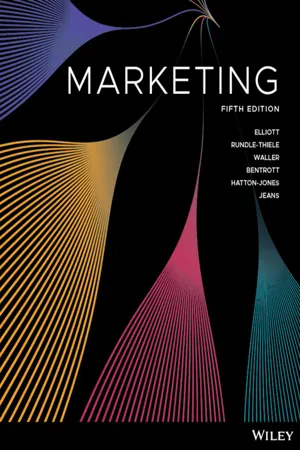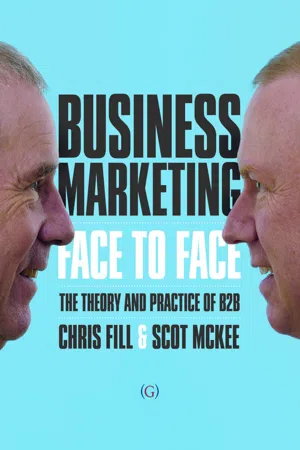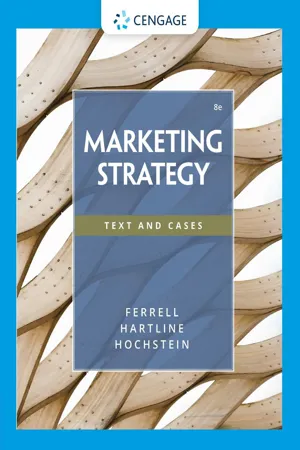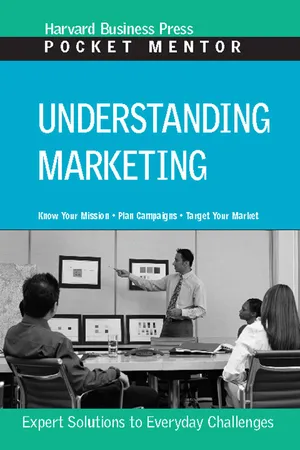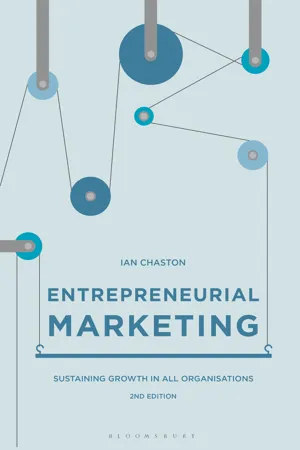Marketing
Business Market
The business market refers to the group of organizations that purchase goods and services for use in their own operations or for resale. This market includes businesses of all sizes, from small enterprises to large corporations, and encompasses a wide range of industries and sectors. Understanding the needs and behaviors of the business market is crucial for developing effective marketing strategies and building successful B2B relationships.
Written by Perlego with AI-assistance
Related key terms
1 of 5
10 Key excerpts on "Business Market"
- eBook - PDF
- Barton A Weitz, Robin Wensley, Barton A Weitz, Robin Wensley(Authors)
- 2002(Publication Date)
- SAGE Publications Ltd(Publisher)
Business Markets are generally defined as markets where both sellers and buyers are businesses or other organizations. Markets where not only sellers but also customers are businesses and other organi-zations are of great significance in all developed economies. It is estimated that the value of trans-actions that are carried out between businesses in an economy such as Sweden’s is about 3–4 times more than the value of transactions between businesses and households. That is only a crude indicator of the importance of these markets. Apart from the volume of exchange, Business Markets are impor-tant arenas for economic and technological development that affect economies of regions and countries. The telecom and biotech markets are but two recent examples of markets that have had important effects both on regional developments and our way of living. Over the last few decades there has been considerable research into the nature of Business Markets and on the marketing practices in compa-nies that operate in these markets. Research findings show that Business Markets display several peculiar features that impact on marketing practices. The peculiarity of Business Markets has its origin in the symmetry of market relationships. We have the same type of actor on both sides – both the selling and buying side are companies or other professional organizations. The symmetry of actors has far-reaching consequences for the market processes. The aim of this chapter is to review the picture of Business Markets as it comes out in contemporary research, to outline their peculiarities and to explore their consequences for marketing management and future directions of marketing research. The chapter is organized around five sections. The first section deals with the distinctive traits of Business Markets recurrently reported in empirical studies. - eBook - PDF
- Greg Elliott, Sharyn Rundle-Thiele, David Waller, Ingo Bentrott, Siobhan Hatton-Jones, Pete Jeans(Authors)
- 2020(Publication Date)
- Wiley(Publisher)
KEY TERMS Business Markets Individuals or organisations that purchase products for resale, use in the production of other products, or for use in their daily business operations. buying centre The groups and structures within an organisation that make business buying decisions. derived demand Demand in Business Markets that is due to demand in consumer markets. government markets The market for selling products to national (Commonwealth), state (provincial) and local (municipal) governments for use in providing services for citizens. inelastic demand Demand that is relatively independent of price, a common characteristic of demand within industries in Business Markets. institutional markets Business Markets in which non-public, not-for-profit organisations buy and sell products. joint demand Interdependent demand for products that are used together in the production of another product. Pdf_Folio:143 CHAPTER 5 Business buying behaviour 143 modified rebuy The purchase of a product that is similar, but not identical, to one a business has previously purchased, after evaluating a small range of alternatives. new task purchase A first purchase in a product category in response to a new problem, process or product. producer markets The markets in which business organisations and professionals purchase products for use in the production of other products or in their daily business operations. reseller markets The market of retailers, wholesalers and other intermediaries that buy products in order to sell or lease them to another party for profit. straight rebuy The low-engagement purchase of the same products as previously purchased from established vendors under established terms. - eBook - PDF
- Chris Fill, Scot McKee(Authors)
- 2011(Publication Date)
- Goodfellow Publishers(Publisher)
Unlike consumer markets, where goods and services are consumed personally by the people who buy them, the essence of Business Markets is that individual organisations undertake the act of consumption. This text is developed around this important principle which has critical implications for the marketing strate-gies and associated programmes that are used to satisfy organisational buyers. Business Marketing: Face to Face 6 1 Before looking at the characteristics of Business Markets and B2B marketing, it is important to note that, although there are several vital differences to consumer marketing, organisations which have a market orientation, regardless of the sector in which they operate, share at least two key similarities: Both have a customer orientation and work backwards from an understand-1 ing of customer needs. Both need the ability to gather, process, and use information about customers 2 and competitors in order to achieve their objectives. This market orientation is an essential foundation upon which to begin exploring the exciting and dynamic world of Business Markets and the contribution of B2B marketing. This chapter introduces various fundamental aspects of B2B marketing. It is designed to provide an overview and to set out the parameters for exploring the subject. It is not intended to provide an in-depth analysis or understanding, but to outline issues and concepts that are covered in detail in later chapters. The Characteristics of Business Markets Business Markets are characterised by a number of factors, the main ones being the nature of demand, the buying processes, international dimensions and, perhaps most importantly, the relationships that develop between organisations in the process of buying and selling. These are now considered from an introduc-tory point of view. The nature of demand One of the key factors is the nature of demand in Business Markets. Three aspects of demand are considered: derivation, variance and elasticity. - eBook - PDF
- O. C. Ferrell, Michael Hartline, O. C. Ferrell, Michael Hartline, Bryan Hochstein(Authors)
- 2021(Publication Date)
- Cengage Learning EMEA(Publisher)
Therefore, they wield a great deal of power in the supply chain. ● ● Government Markets. These markets include federal, state, county, city, and local governments. Governments buy a wide range of finished goods ranging from aircraft carriers to fire trucks to office equipment. However, most government purchases are for the services provided to citizens, such as education, fire and police protection, maintenance and repair of roads, and water and sewage treatment. ● ● Institutional Markets. These markets consist of a diverse group of noncommercial organizations such as churches, charities, schools, hospitals, or professional organizations. These organizations primarily buy finished goods that facilitate their ongoing operations. 5.3a Unique Characteristics of Business Markets Business Markets differ from consumer markets in at least five ways. These differences concern the nature of the decision-making unit, the role of hard and soft costs in making and evaluating purchase decisions, reciprocal buying relationships, and the dependence of the two parties on each other. As a general rule, these differences are more acute for firms attempting to build long- term client relationships. In Business Markets, buying needed products at the lowest possible price is not necessarily the most important objective. Since many business transactions are based on long-term relationships, trust, reliability, and overall goal attainment are often much more im- portant than the price of the product. The Buying Center The first key difference relates to the role of the buying center—the group of people responsible for making purchase decisions. In consumer markets, the buying center is fairly straightforward: The adult head-of-household tends to make most major purchase decisions for the family, with input and assistance from children and other family members as applicable. - eBook - PDF
- O. C. Ferrell, Michael Hartline, (Authors)
- 2018(Publication Date)
- Cengage Learning EMEA(Publisher)
However, most government pur- chases are for the services provided to citizens, such as education, fire and police protection, maintenance and repair of roads, and water and sewage treatment. • Institutional Markets. These markets consist of a diverse group of noncommercial organizations such as churches, charities, schools, hospitals, or professional organizations. These organizations primarily buy finished goods that facilitate their ongoing operations. Unique Characteristics of Business Markets Business Markets differ from consumer markets in at least four ways. These differ- ences concern the nature of the decision-making unit, the role of hard and soft costs in making and evaluating purchase decisions, reciprocal buying relationships, and the dependence of the two parties on each other. As a general rule, these differ- ences are more acute for firms attempting to build long-term client relationships. In Business Markets, buying needed products at the lowest possible price is not neces- sarily the most important objective. Since many business transactions are based on long-term relationships, trust, reliability, and overall goal attainment are often much more important than the price of the product. The Buying Center The first key difference relates to the role of the buying center—the group of people responsible for making purchase decisions. In consumer markets, the buying center is fairly straightforward: The adult head-of-household tends to make most major pur- chase decisions for the family, with input and assistance from children and other fam- ily members as applicable. In an organization, however, the buying center tends to be much more complex and difficult to identify, in part because it may include three dis- tinct groups of people—economic buyers, technical buyers, and users—each of which may have its own agenda and unique needs that affect the buying decision. - eBook - PDF
- Louis Boone, , David Kurtz, , Louis Boone, David Kurtz(Authors)
- 2018(Publication Date)
- Cengage Learning EMEA(Publisher)
PART 2 UNDERSTANDING BUYERS AND MARKETS 134 For most consumer purchases though, such as items you might purchase at the grocery store, advertising is a more cost-effective form of promotion. DISTRIBUTION Business Market distribution channels are typically shorter and more direct, with products passing through fewer intermediaries than they do for consumer markets. GEOGRAPHIC MARKET CONCENTRATION The U.S. Business Market is more geographically concentrated than the con-sumer market. Manufacturers often converge in certain regions of the coun-try, making these areas prime targets for Business Marketers. For example, the Midwestern states of Indiana, Wisconsin, Iowa, Michigan, and Ohio lead the nation in manufacturing, which is a significant driver of the Business Market. In the automobile industry, suppliers build plants close to their customers. Volkswagen’s supplier park near its Chattanooga assembly plant is home to more than 17 different vendors. The campus allows suppliers to produce or assem-ble products close to the plant, reducing costs, controlling parts inventory, and increasing flexibility. BUYER–SELLER RELATIONSHIPS An especially important characteristic of Business Markets is the relationship between buyers and sellers. These relationships often are more enduring and complex than consumer–market relationships. In the Business Market, a single transaction may generate millions of dollars for a company. PURCHASE DECISION PROCESS Suppliers who serve Business Markets must work with multiple decision makers, especially when selling to larger organizations. Managers at several levels may influence final orders, and the overall process is more formal and professional than the consumer purchasing process. As a result, business purchases typically require longer time frames. Exhibit 7.1 compares the business and consumer markets. Based on these differences, Exhibit 7.2 describes how the differences might play out in the real world. - eBook - PDF
- William Pride, O. C. Ferrell(Authors)
- 2019(Publication Date)
- Cengage Learning EMEA(Publisher)
Business (B2B) markets consist of individuals, organizations, and groups that purchase a specific kind of product for resale, direct use in producing other products, or use in day-to-day operations. Producer markets include those individuals and business organizations that purchase products for the purpose of making a profit by using them to produce other products or as part of their operations. Intermediaries that buy finished products and resell them to make a profit are classified as reseller markets. Government markets consist of federal, state, county, and local governments, which spend billions of dollars annually for goods and services to support internal operations and to provide citizens with needed services. Organizations with charitable, educational, community, or other nonprofit goals constitute institutional markets. 8-2 Define the North American Industry Classification System and describe how it can be used to identify and analyze Business Markets. Business Marketers have a considerable amount of informa- tion available for use in planning marketing strategies. The North American Industry Classification System (NAICS) is a single industry classification system used by the United States, Canada, and Mexico to generate comparable statis- tics. It provides marketers with information needed to identify business customer groups. It can best be used for this purpose in conjunction with other information. After identifying target industries, a marketer can obtain the names and locations of potential customers by using government and commercial data sources. Marketers then must estimate potential purchases of business customers by finding a relationship between a poten- tial customer’s purchases and a variable available in industrial classification data. 8-3 Identify the major characteristics of business customers and transactions. Transactions that involve business customers differ from consumer transactions in several ways. - eBook - PDF
- (Author)
- 2010(Publication Date)
- Harvard Business Review Press(Publisher)
On the other hand, your company’s primary market may shift over time if such a change would have strategic value. To illustrate, an automobile manufacturer that sells mainly to individuals might see some advantages in developing and marketing certain kinds of vehicles—such as limousines—for business customers. In the next sections, we’ll look first at ways to market to con-sumers and then at ways to market to businesses. When Your Company Markets to Consumers 15 16 Understanding Marketing I f your company markets to consumers, it’s vital to under-stand the forces affecting consumer buying, the process that consumers go through when they’re buying, and the strategies that can help you deepen your understanding of consumers. Forces affecting consumer buying Understanding the forces that affect consumers’ buying behavior helps you identify the most appropriate offering to fulfill your tar-get customers’ demands. The truth is that people decide to buy products and services for many different reasons. The table “What Affects Consumer Buying?” shows just a few examples of the forces—cultural, social, personal, and psychological—that most influence individuals’ purchasing decisions. The buying process In addition to being influenced by a range of forces in their buying behaviors, consumers go through a fairly predictable series of steps when they decide whether to buy something. You’ve proba-bly followed these steps many times: 1. Recognize a need —for example, your computer has become outdated, and you need a new one. - eBook - PDF
Entrepreneurial Marketing
Sustaining Growth in All Organisations
- Ian Chaston(Author)
- 2017(Publication Date)
- Red Globe Press(Publisher)
276 B2B Marketing CHAPTER AIMS (1) Introduce B2B marketing processes. (2) Examine B2B marketing strategies and policies. (3) Review B2B market innovation. (4) Review the utilisation of business networks. (5) Examine the utilisation of the social media. 15.1 MARKET OPPORTUNITIES The ultimate destiny of all firms is determined by final customer demand. In the case of B2B operations forecasting future demand is complicated by the exist-ence of what is known as ‘derived demand’. This is based upon the fact that ulti-mately B2B company sales are not determined by the purchase behaviour of the firm’s customers but by the activities of organisations further downstream in the supply chain. The performance of these latter entities is in turn controlled by the prevailing trends in consumer purchasing behaviour. Thus, for example an elec-tronics company might develop a new, low-energy microchip which is used as a component by a company manufacturing security alarms which are marketed by distributors who provide security services to owners of upmarket houses. In this case the derived demand for the new microchip is determined by the number of consumers who decide to have their home security systems upgraded. Another feature of B2B markets is that the number of customers is usually much lower than in a consumer market, and, furthermore, each of these cus-tomers usually purchases a significant proportion of a supplier’s total sales. In some cases, the B2B firm is engaged in supplying components or services which are utilised by larger companies for incorporation into the products that they 15 B2B MARKETING 277 manufacture. This output may be sold to another B2B customer (e.g. vehicles sold to truck fleet operators) or via an intermediary to a consumer market (e.g. vehicles sold to the general public). - eBook - PDF
- Malcolm McDonald, Ailsa Kolsaker(Authors)
- 2017(Publication Date)
- Red Globe Press(Publisher)
Marketers in B2B situations thus require specialist knowledge and understanding of context, trends, market structure and conditions, consumer demand, competitors and B2B decision-making processes. As a rule, organizational buying decisions are born from necessity. A pur-chase invariably starts from within the buyer’s organization as some kind of problem or need. The remaining ‘buy stages’ gradually unfold, sometimes over a period of weeks or even months. Although, due to the varying nature of busi-ness contexts, it is bold to generalize, as a rule, buying decisions can be relatively complex and protracted. As a comparator to B2C, Figure 3.1 indicates the stages of a ‘typical’ organizational buying decision. Need recognition Specify required solution Prepare details spec. Locate potential supplier Invite tenders Evaluate tenders Select supplier Place trial order Review & evaluate Negotiate main contract Monitor & manage Figure 3.1 Typical organizational buying process DRIVERS OF CHANGE The business environment is increasingly global, dynamic and transparent, forcing companies to engage in a perpetual quest for greater efficiency, pro-ductivity and cost-effectiveness alongside ever-higher quality and customer-responsiveness. Simultaneous pursuit of these essentially dichotomous routes 41 CHAPTER 3 – ORGANIZATIONAL BUYING BEHAVIOUR can be problematic, so it is important to map and understand the key drivers of change in order to develop appropriate strategies. CUSTOMER EXPERTISE, SOPHISTICATION AND POWER Customers are becoming more and more demanding in their expectations of quality, reliability and compatibility. They increasingly demand customized solutions, fuelled by technological developments (Information and Communi-cations Technology (ICT) and the Internet, in particular) and the concentration of buying power in fewer hands.
Index pages curate the most relevant extracts from our library of academic textbooks. They’ve been created using an in-house natural language model (NLM), each adding context and meaning to key research topics.

